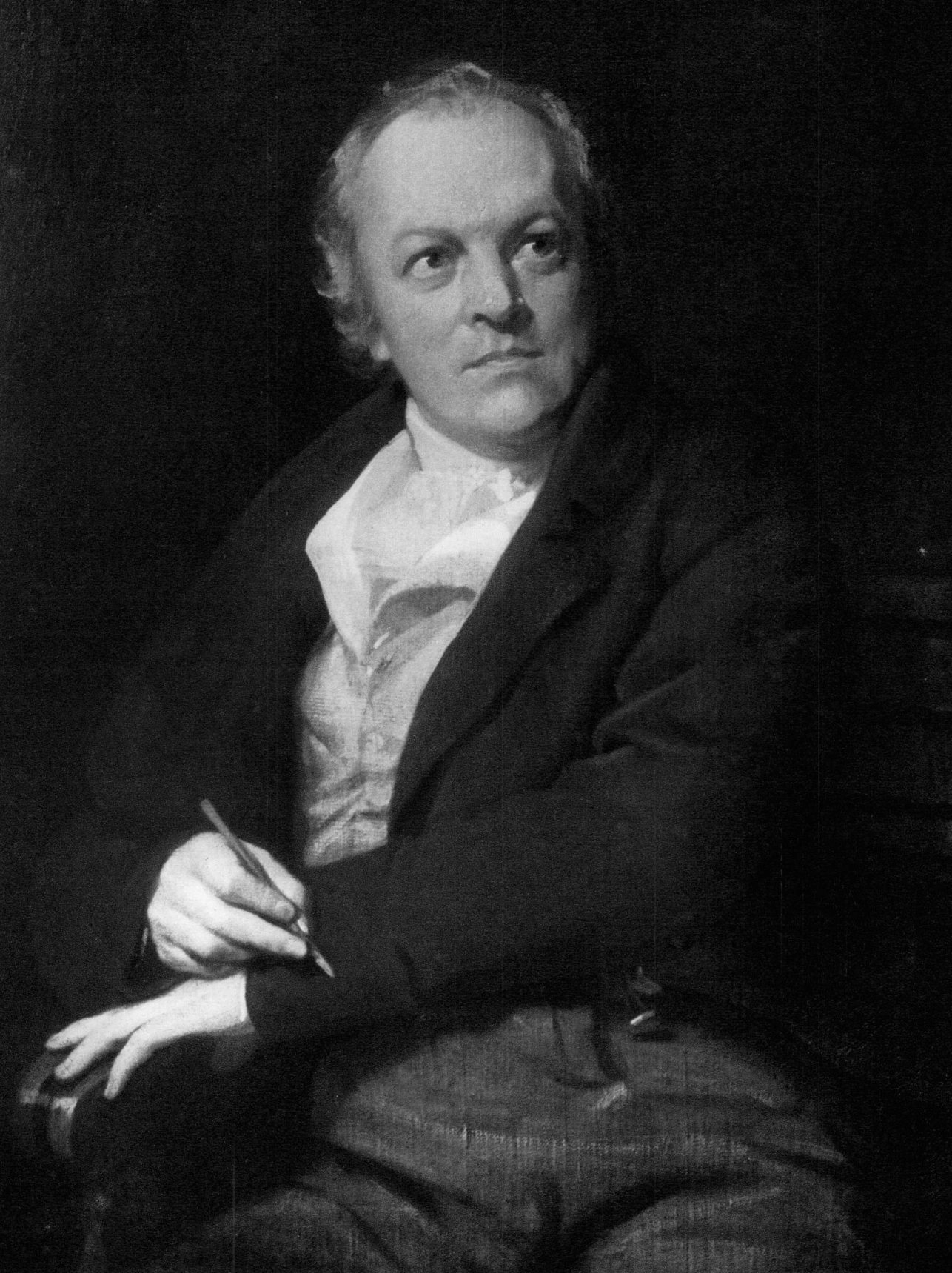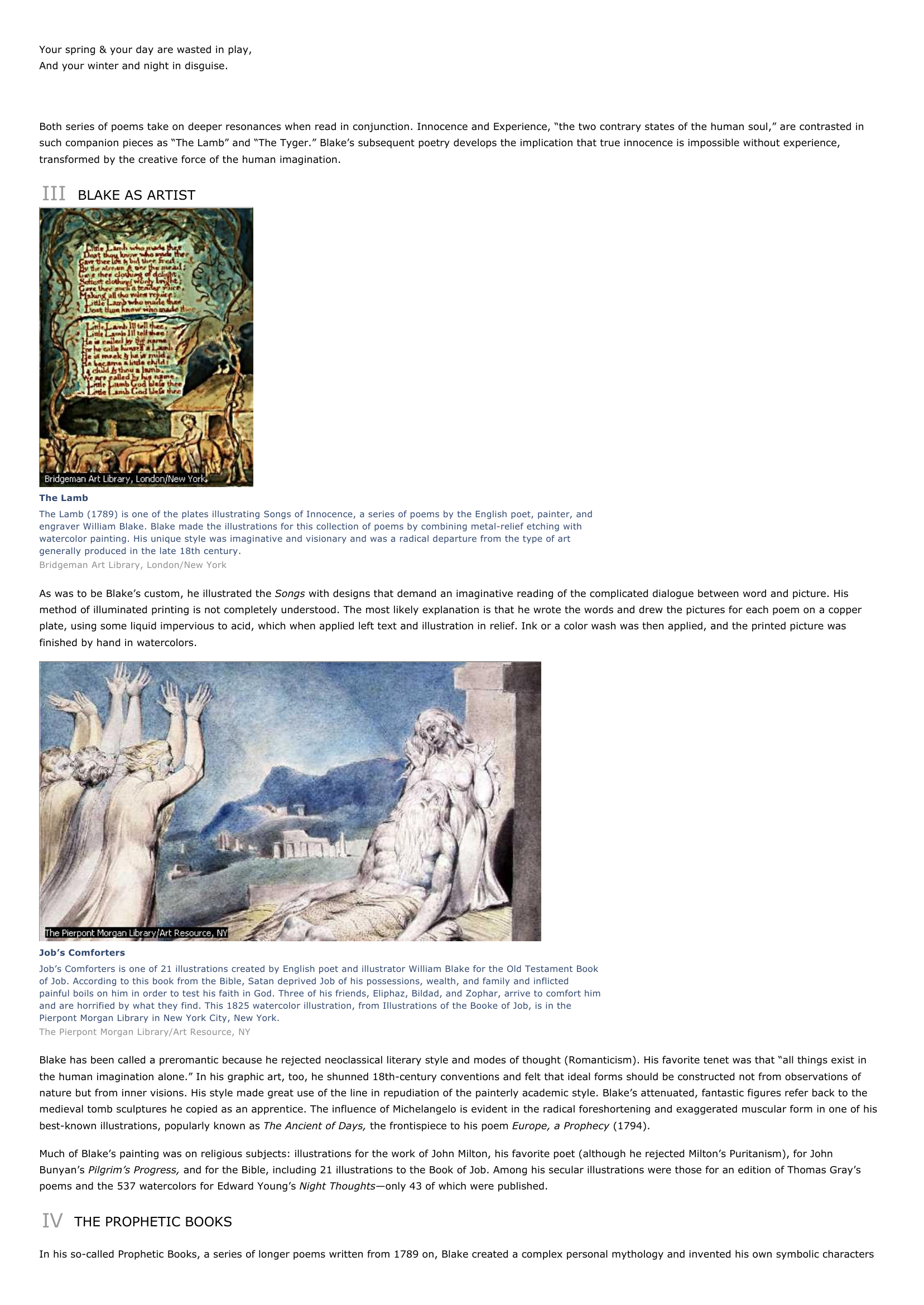William Blake I INTRODUCTION William Blake (1757-1827), English poet, painter, and engraver, who created an unusual form of illustrated verse; his poetry, inspired by mystical vision, is among the most original, lyric, and prophetic in the language.
Publié le 12/05/2013

Extrait du document


«
Your spring & your day are wasted in play,And your winter and night in disguise.
Both series of poems take on deeper resonances when read in conjunction.
Innocence and Experience, “the two contrary states of the human soul,” are contrasted insuch companion pieces as “The Lamb” and “The Tyger.” Blake’s subsequent poetry develops the implication that true innocence is impossible without experience,transformed by the creative force of the human imagination.
III BLAKE AS ARTIST
The LambThe Lamb (1789) is one of the plates illustrating Songs of Innocence, a series of poems by the English poet, painter, andengraver William Blake.
Blake made the illustrations for this collection of poems by combining metal-relief etching withwatercolor painting.
His unique style was imaginative and visionary and was a radical departure from the type of artgenerally produced in the late 18th century.Bridgeman Art Library, London/New York
As was to be Blake’s custom, he illustrated the Songs with designs that demand an imaginative reading of the complicated dialogue between word and picture.
His method of illuminated printing is not completely understood.
The most likely explanation is that he wrote the words and drew the pictures for each poem on a copperplate, using some liquid impervious to acid, which when applied left text and illustration in relief.
Ink or a color wash was then applied, and the printed picture wasfinished by hand in watercolors.
Job’s ComfortersJob’s Comforters is one of 21 illustrations created by English poet and illustrator William Blake for the Old Testament Bookof Job.
According to this book from the Bible, Satan deprived Job of his possessions, wealth, and family and inflictedpainful boils on him in order to test his faith in God.
Three of his friends, Eliphaz, Bildad, and Zophar, arrive to comfort himand are horrified by what they find.
This 1825 watercolor illustration, from Illustrations of the Booke of Job, is in thePierpont Morgan Library in New York City, New York.The Pierpont Morgan Library/Art Resource, NY
Blake has been called a preromantic because he rejected neoclassical literary style and modes of thought (Romanticism).
His favorite tenet was that “all things exist inthe human imagination alone.” In his graphic art, too, he shunned 18th-century conventions and felt that ideal forms should be constructed not from observations ofnature but from inner visions.
His style made great use of the line in repudiation of the painterly academic style.
Blake’s attenuated, fantastic figures refer back to themedieval tomb sculptures he copied as an apprentice.
The influence of Michelangelo is evident in the radical foreshortening and exaggerated muscular form in one of hisbest-known illustrations, popularly known as The Ancient of Days, the frontispiece to his poem Europe, a Prophecy (1794).
Much of Blake’s painting was on religious subjects: illustrations for the work of John Milton, his favorite poet (although he rejected Milton’s Puritanism), for JohnBunyan’s Pilgrim’s Progress, and for the Bible, including 21 illustrations to the Book of Job.
Among his secular illustrations were those for an edition of Thomas Gray’s poems and the 537 watercolors for Edward Young’s Night Thoughts —only 43 of which were published.
IV THE PROPHETIC BOOKS
In his so-called Prophetic Books, a series of longer poems written from 1789 on, Blake created a complex personal mythology and invented his own symbolic characters.
»
↓↓↓ APERÇU DU DOCUMENT ↓↓↓
Liens utiles
- William Shakespeare I INTRODUCTION William Shakespeare English playwright and poet William Shakespeare, who lived in the late 1500s and early 1600s, is regarded as the greatest dramatist in the history of English literature.
- Dante Alighieri I INTRODUCTION Dante Alighieri (1265-1321), Italian poet, and one of the supreme figures of world literature, who was admired for the depth of his spiritual vision and for the range of his intellectual accomplishment.
- Edgar Allan Poe I INTRODUCTION Edgar Allan Poe (1809-1849), American writer, known as a poet and critic but most famous as the first master of the short-story form (see Short Story), especially the psychological horror tale.
- John Huston John Huston (1906-1987), American motion-picture director and actor, who created some of the most critically acclaimed films of American cinema in his long and distinguished career.
- Charlie Chaplin Charlie Chaplin (1889-1977), English motion-picture actor, director, producer, and composer, one of the most creative artists in film history, who first achieved worldwide fame through his performances in silent films.





















